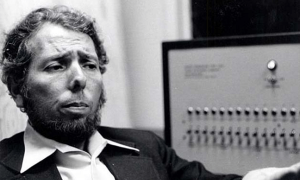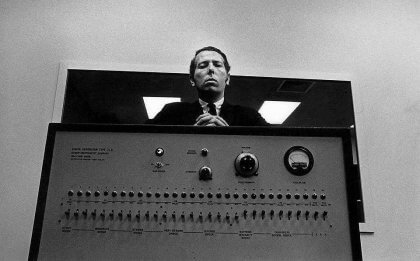Blind Obedience: Milgram's Experiment

Why does a person obey? To what extent can a person follow an order that goes against their morals? Stanley Milgram’s experiment (1963) may have answered these questions. Answering these questions was his intention.
This experiment is one of the most famous ones in the history of psychology. It also revolutionizes the ideas we have about human beings. Most of all, it gives us a very powerful explanation about why good people can sometimes be very cruel. Are you ready to learn about the Milgram experiment?
The Milgram experiment on blind obedience
Before analyzing obedience, we will first talk about how he did the experiment. First, Milgram placed an ad in the newspaper looking for people who would we willing to get paid to participate in a psychological study. When the subjects arrived at the Yale University laboratory, a researcher told them that they would be participating in an investigation about learning.
In addition, their role in the study was explained to them this way: they would ask another subject about a list of words to evaluate memory. However . . .
This explanation was a lie that hid the real experiment. The subject thought he was asking questions to another subject, when really the other person was an accomplice of the researcher. The subject’s mission was to ask the accomplice about a list of words that he had previously memorized. If the accomplice answered correctly, they would move on to the next word. If the accomplice failed to answer correctly, the subject was told to give the accomplice an electric shock (no shock was really given, but the subject couldn’t see this).
The subject was told that the machine which shocked the accomplice had 30 levels of intensity. For every mistake the accomplice made, the subject had to increase the force of the shock. Before the experiment began, the accomplice was given several small “shocks” and expressed how painful they were to the subject.

At the beginning of the experiment, the accomplice answers the subject’s questions correctly without any problem. However, as the experiment progresses, they begin to answer incorrectly and the subject must apply the shocks. While the subject cannot see the accomplice, they can hear them. The accomplice’s performance is as follows: when level 10 intensity was reached, he started complaining about the experiment and wanting to quit. At level 15 of the experiment, he would refuse to answer and show determination in opposing the experiment. Upon reaching level 20 of the experiment, he would “faint” and therefore be unable to answer more questions.
At all times, the researcher with the subject would urge the subject to continue the test, even when the accomplice pretends to pass out. The researcher says not answering is also considered a wrong answer. So the subject doesn’t become tempted to abandon the experiment, the researcher reminds the subject that he is committed to finishing and that the researcher’s responsible for what happens.
Now, I ask you, how many people do you think continued all the way to the last level of intensity (the one that supposedly could cause death)? How many do you think reached the level where the accomplice “faints”? Well, let’s look at the results of these “obedient criminals.”
Results of the Milgram Experiment
Before performing the experiment, Milgram asked some of his psychiatric colleagues to make a prediction about the results. Most thought the subjects wound abandon the experiment after the accomplice’s first complaint. They believed about 4% would reach the level which caused the accomplice to pretend to faint. In addition, they thought that only one in a thousand would reach the final level and that it would indicate a pathological issue (Milgram, 1974).
They were totally wrong. Of the 40 subjects in the first testing round, 25 reached the end. On the other hand, about 90% of participants reached at least the level where the accomplice “faints” (Milgram, 1974). The participants obeyed the researcher in everything, even though some of them showed high levels of stress at the thought of hurting another person.

Milgram was told that the sample could be biased, but this study has been widely replicated with different samples and designs that we can consult in the Milgram book (2016). All of them had similar results. A researcher in Munich found that 85 percent of his subjects reached the maximum shock level (Milgram, 2005).
Shanab (1978) and Smith (1998) show us in their studies that the results are generalizable to any other Western country. Even so, we must be careful when thinking that we0re facing a universal social behavior: trans-cultural research does not show conclusive results.
Conclusions from the Milgram Experiment
The first question we ask ourselves after seeing these results is, why did people obey up to those levels? In Milgram (2016), there are multiple transcripts of subjects’ conversations with the researcher. In them, we observe that most subjects felt bad about their behavior. Therefore, cruelty doesn’t motivate them. The answer may lie in the researcher’s “authority” of the researcher, in whom the subjects relegate responsibility for what happens.
Through variations of the Milgram experiment, researchers extracted a series of factors that affected obedience:
- The role of the researcher: the presence of a researcher dressed in a lab coat makes the subjects see him as an authority figure. They see his professionalism and therefore are more obedient to the researcher’s requests.
- Perceived responsibility: this is the responsibility the subject believes he has over his actions. When the researcher tells the subject that the researcher’s responsible for the experiment, the subject doesn’t feel much pressure. In this way, it’s easier for him to obey.
- The consciousness of a hierarchy: those subjects who felt strongly about hierarchy were able to see themselves as above the accomplice and below the researcher. Therefore, they gave more importance to the orders of their “boss” than to the welfare of the accomplice.
- Feeling of commitment: the fact that the participants had committed themselves to carry out the experiment made it harder for them to oppose it.
- The rupture of empathy: when the situation forced the depersonalization of the accomplice, it was easier for the subject to lose empathy towards him and obey the researcher.
These factors alone do not make a person blindly obey someone, but the sum of them generates a situation in which obedience becomes very likely regardless of the consequences. The Milgram Experiment shows us an example of the strength of the situation that Zimbardo (2012) talks about. If we’re not aware of the strength of our context, this can push us to behave outside our principles.
People obey blindly because the pressure of the aforementioned factors outweighs the pressure of personal conscience. This helps us explain many historical events, such as the great support for fascist dictatorships over the last century. It also explains more concrete events, such as the behavior and explanations of the doctor who assisted in the extermination of the Jews during World War II.

Sense of obedience
Whenever we see behaviors that don’t match our expectations, it’s interesting to figure out what causes them. Psychology gives us a very interesting explanation of obedience. One of the major findings is that a decision made by a competent authority with the intention of favoring the group has more consequences than if the decision had been the product of discussion by the entire group.
Imagine a society under the command of an authority that isn’t questioned versus a society in which the authority figure is constantly put to the test. Having no control mechanisms, logically the first will be much faster at following orders than the second. This is a very important variable that can determine victory or defeat in a conflict situation. This is also closely related to Tajfel‘s social identity theory (1974).
Now, what can we do in the face of blind obedience? Authority and hierarchy may be adaptive in certain contexts, but that does not legitimize blind obedience to an immoral authority. Here we face a problem. If we achieve a society in which any authority is questioned, we will have a healthy and fair community. However, that will fall before other societies during a conflict because it’s slow to make decisions.
At the individual level, if we want to avoid falling into blind obedience, it’s important to also keep in mind that any one of us can fall victim to the pressures of the situation. For this reason, the best defense we have is to be aware of how context factors affect us. This way, when they threaten to overcome us, we can try to regain control and not delegate a responsibility that belongs to us, however great the temptation.

Experiments like this help us reflect on the human condition. They allow us to see that dogmas such as the idea of being good or bad are too black and white to explain our reality. Experiments like this are necessary to shed light on the complexity of human behavior and understand the reasons for it. Knowing this will help us understand our history and not repeat certain actions.
Bibliography
Milgram, S. (1963). Behavioral study of obedience. Journal of Abnormal and Social Psychology, 67, 371-378.
Milgram, S. (1974). Obedience to authority: An experimental view. New York: Harper and Row
Milgram, S. (2005). Los peligros de la obediciencia. POLIS, Revista Latinoamericana.
Milgram, S., Goitia, J. de, & Bruner, J. (2016). Obediencia a la autoridad : el experimento Milgram. Capitan Swing.
Shanab, M. E., & Yahya, K. A. (1978). A cross-cultural study of obedience. Bulletin of the Psychonomic Society.
Smith, P. B., & Bond, M. H. (1998). Social psychology across cultures (2nd Edition). Prentice Hall.
Tajfel, H. (1974). Social identity and intergroup behaviour. Social Science Information, 13, 65-93.
Zimbardo, P. G. (2012). El efecto Lucifer: el porqué de la maldad.
Why does a person obey? To what extent can a person follow an order that goes against their morals? Stanley Milgram’s experiment (1963) may have answered these questions. Answering these questions was his intention.
This experiment is one of the most famous ones in the history of psychology. It also revolutionizes the ideas we have about human beings. Most of all, it gives us a very powerful explanation about why good people can sometimes be very cruel. Are you ready to learn about the Milgram experiment?
The Milgram experiment on blind obedience
Before analyzing obedience, we will first talk about how he did the experiment. First, Milgram placed an ad in the newspaper looking for people who would we willing to get paid to participate in a psychological study. When the subjects arrived at the Yale University laboratory, a researcher told them that they would be participating in an investigation about learning.
In addition, their role in the study was explained to them this way: they would ask another subject about a list of words to evaluate memory. However . . .
This explanation was a lie that hid the real experiment. The subject thought he was asking questions to another subject, when really the other person was an accomplice of the researcher. The subject’s mission was to ask the accomplice about a list of words that he had previously memorized. If the accomplice answered correctly, they would move on to the next word. If the accomplice failed to answer correctly, the subject was told to give the accomplice an electric shock (no shock was really given, but the subject couldn’t see this).
The subject was told that the machine which shocked the accomplice had 30 levels of intensity. For every mistake the accomplice made, the subject had to increase the force of the shock. Before the experiment began, the accomplice was given several small “shocks” and expressed how painful they were to the subject.

At the beginning of the experiment, the accomplice answers the subject’s questions correctly without any problem. However, as the experiment progresses, they begin to answer incorrectly and the subject must apply the shocks. While the subject cannot see the accomplice, they can hear them. The accomplice’s performance is as follows: when level 10 intensity was reached, he started complaining about the experiment and wanting to quit. At level 15 of the experiment, he would refuse to answer and show determination in opposing the experiment. Upon reaching level 20 of the experiment, he would “faint” and therefore be unable to answer more questions.
At all times, the researcher with the subject would urge the subject to continue the test, even when the accomplice pretends to pass out. The researcher says not answering is also considered a wrong answer. So the subject doesn’t become tempted to abandon the experiment, the researcher reminds the subject that he is committed to finishing and that the researcher’s responsible for what happens.
Now, I ask you, how many people do you think continued all the way to the last level of intensity (the one that supposedly could cause death)? How many do you think reached the level where the accomplice “faints”? Well, let’s look at the results of these “obedient criminals.”
Results of the Milgram Experiment
Before performing the experiment, Milgram asked some of his psychiatric colleagues to make a prediction about the results. Most thought the subjects wound abandon the experiment after the accomplice’s first complaint. They believed about 4% would reach the level which caused the accomplice to pretend to faint. In addition, they thought that only one in a thousand would reach the final level and that it would indicate a pathological issue (Milgram, 1974).
They were totally wrong. Of the 40 subjects in the first testing round, 25 reached the end. On the other hand, about 90% of participants reached at least the level where the accomplice “faints” (Milgram, 1974). The participants obeyed the researcher in everything, even though some of them showed high levels of stress at the thought of hurting another person.

Milgram was told that the sample could be biased, but this study has been widely replicated with different samples and designs that we can consult in the Milgram book (2016). All of them had similar results. A researcher in Munich found that 85 percent of his subjects reached the maximum shock level (Milgram, 2005).
Shanab (1978) and Smith (1998) show us in their studies that the results are generalizable to any other Western country. Even so, we must be careful when thinking that we0re facing a universal social behavior: trans-cultural research does not show conclusive results.
Conclusions from the Milgram Experiment
The first question we ask ourselves after seeing these results is, why did people obey up to those levels? In Milgram (2016), there are multiple transcripts of subjects’ conversations with the researcher. In them, we observe that most subjects felt bad about their behavior. Therefore, cruelty doesn’t motivate them. The answer may lie in the researcher’s “authority” of the researcher, in whom the subjects relegate responsibility for what happens.
Through variations of the Milgram experiment, researchers extracted a series of factors that affected obedience:
- The role of the researcher: the presence of a researcher dressed in a lab coat makes the subjects see him as an authority figure. They see his professionalism and therefore are more obedient to the researcher’s requests.
- Perceived responsibility: this is the responsibility the subject believes he has over his actions. When the researcher tells the subject that the researcher’s responsible for the experiment, the subject doesn’t feel much pressure. In this way, it’s easier for him to obey.
- The consciousness of a hierarchy: those subjects who felt strongly about hierarchy were able to see themselves as above the accomplice and below the researcher. Therefore, they gave more importance to the orders of their “boss” than to the welfare of the accomplice.
- Feeling of commitment: the fact that the participants had committed themselves to carry out the experiment made it harder for them to oppose it.
- The rupture of empathy: when the situation forced the depersonalization of the accomplice, it was easier for the subject to lose empathy towards him and obey the researcher.
These factors alone do not make a person blindly obey someone, but the sum of them generates a situation in which obedience becomes very likely regardless of the consequences. The Milgram Experiment shows us an example of the strength of the situation that Zimbardo (2012) talks about. If we’re not aware of the strength of our context, this can push us to behave outside our principles.
People obey blindly because the pressure of the aforementioned factors outweighs the pressure of personal conscience. This helps us explain many historical events, such as the great support for fascist dictatorships over the last century. It also explains more concrete events, such as the behavior and explanations of the doctor who assisted in the extermination of the Jews during World War II.

Sense of obedience
Whenever we see behaviors that don’t match our expectations, it’s interesting to figure out what causes them. Psychology gives us a very interesting explanation of obedience. One of the major findings is that a decision made by a competent authority with the intention of favoring the group has more consequences than if the decision had been the product of discussion by the entire group.
Imagine a society under the command of an authority that isn’t questioned versus a society in which the authority figure is constantly put to the test. Having no control mechanisms, logically the first will be much faster at following orders than the second. This is a very important variable that can determine victory or defeat in a conflict situation. This is also closely related to Tajfel‘s social identity theory (1974).
Now, what can we do in the face of blind obedience? Authority and hierarchy may be adaptive in certain contexts, but that does not legitimize blind obedience to an immoral authority. Here we face a problem. If we achieve a society in which any authority is questioned, we will have a healthy and fair community. However, that will fall before other societies during a conflict because it’s slow to make decisions.
At the individual level, if we want to avoid falling into blind obedience, it’s important to also keep in mind that any one of us can fall victim to the pressures of the situation. For this reason, the best defense we have is to be aware of how context factors affect us. This way, when they threaten to overcome us, we can try to regain control and not delegate a responsibility that belongs to us, however great the temptation.

Experiments like this help us reflect on the human condition. They allow us to see that dogmas such as the idea of being good or bad are too black and white to explain our reality. Experiments like this are necessary to shed light on the complexity of human behavior and understand the reasons for it. Knowing this will help us understand our history and not repeat certain actions.
Bibliography
Milgram, S. (1963). Behavioral study of obedience. Journal of Abnormal and Social Psychology, 67, 371-378.
Milgram, S. (1974). Obedience to authority: An experimental view. New York: Harper and Row
Milgram, S. (2005). Los peligros de la obediciencia. POLIS, Revista Latinoamericana.
Milgram, S., Goitia, J. de, & Bruner, J. (2016). Obediencia a la autoridad : el experimento Milgram. Capitan Swing.
Shanab, M. E., & Yahya, K. A. (1978). A cross-cultural study of obedience. Bulletin of the Psychonomic Society.
Smith, P. B., & Bond, M. H. (1998). Social psychology across cultures (2nd Edition). Prentice Hall.
Tajfel, H. (1974). Social identity and intergroup behaviour. Social Science Information, 13, 65-93.
Zimbardo, P. G. (2012). El efecto Lucifer: el porqué de la maldad.
This text is provided for informational purposes only and does not replace consultation with a professional. If in doubt, consult your specialist.







